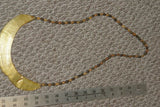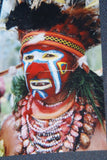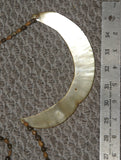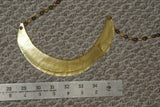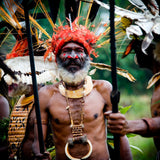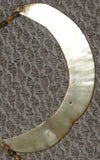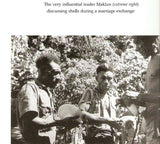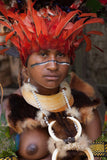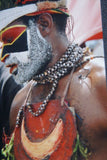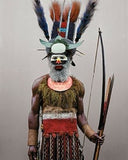Bride Price Currency, Rare Older Ceremonial Moka Kina Shell Necklace (Huge Mother of Pearl Crescent) with Seed Bead Chain, Pectoral Collected from the Foi Tribe (New guinea), Mid 1900’s, Highly Collectible. KINA5
Shells are Gold to the remote tribes of the highlands of Papua New Guinea, and Kina jewelry is, with balers, the most important of all.
Beautiful Rare Authentic Old Tribal Kina Ceremonial Necklace with 2-toned seed beads alternated, prized pectoral decoration from the Foi Tribe, highlands of Papua New Guinea.
Mount-Hagen area. ( mid 20th Century).
This older Gold lip shell (Pinctada maximums) was carved in a ½ moon shape from a gigantic shell, also called the Kina (as the local money’s name is). If shell’s borders are uneven, it is expected from a shell.
Item KINA5 OR 160A22 in our inventory , South Pacific.
(Papou Pygmy Tribe Body Art, also valuable currency used as money to this day)
This object of value from Papua New Guinea (PNG), an important Pectoral adornment considered currency in trade or exchanges, has passed from hand to hand, as a prize possession, many times. The huge and prized shell is old and the hand beaded seed beads’ strap has been replaced over the years by newer ones since the humid weather would have caused each one to deteriorate eventually.
The shell itself is very valuable to the tribe and indicate power and wealth, an important possession, often used as currency.
At feasts or bride negotiations, together with other bride presents, a corresponding number of Kina Shells were presented on a tray.
The Kina Shell is part of the shell of the Gold lip shell (Pinctada maximums) and was part of the traditional payment and medium of exchange in Papua New Guinea and Irian Jaya. It is at the origin of the name given to the modern currency: "Kina", in Papua New Guinea.
These shells are still used in traditional ceremonial payments and currency to this day throughout Papua New Guinea. Traded from the coast into the highlands, Kina shells are used for bride price, blood feud paybacks, wealth displays and exchange festivals.
When the Leahy brothers came into the Highlands of Papua New Guinea searching for gold, they found people who valued the gold-lipped pearl shell as much as the miners valued gold. Shells are valuable all over New Guinea, but especially so in the Highlands where the traditional trading contacts between tribes slowly passed shells from ocean to mountain valleys. The mountain people had no concept of the sea, but they wanted the rare, glowing shells. After contact, at the time, the Leahy's and others flew in thousands of shells to pay their laborers.
Kinas, mother of pearl necklaces, are rare treasures from Papua, were worn either alone or in quantities and made of large mother of pearl moon shaped pieces (the gold-lipped pearl shell is cut into crescent shapes called kina).
Warriors wear kina shells as displays of wealth and focus of their dress.
The polished, crescent-shaped shell with 2 drillings at each end is considered a true object of value. Some Kina Shells have a broad woven band, some have a simple cord with pulled up seed capsules or beads, or just a simple carrying cord.
The Kina Shell was an object of value and an essential part of the bride price. The value is judged by the condition of the shell, the size and the color.
In the past, 8 Kina Shells were worth a fully-grown pig, for one shell one could get 1 small pig. The value of the Kina Shell surely varied from region to region. Until the 1960`s it had a fixed exchange rate of 12 shillings per pair
We carry many other artifacts we collect direct from the tribes, in East and West Papua and the Trobriands and remote islands of Indonesia.
All our collector and rare items come with pages and pages of research about provenance, and with history of the tribes and photos as well, depending on item and whenever possible. When shipping internationally, we group ship multiple purchases to save you money, and find the best rates available. If you have any questions or want to see research conducted on this piece and photos of tribes, tell us.



























